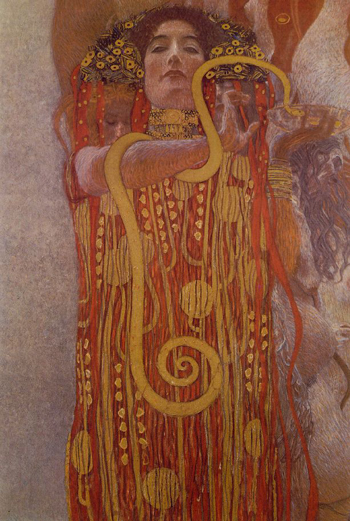
Hygeia

|
Hygeia
Famed Austrian mural artist, Gustav Klimt, created ‘Hygeia’ in 1907 for the University of Vienna. He was commissioned to create three paintings to decorate the ceiling of the university’s “Great Hall”. The pieces came to be known as “The Faculty Paintings”. The work consisted of three themes: Philosophy, Medicine, and Jurisprudence, with ‘Hygeia’ (daughter of the god of medicine) representing the medical field.
Description of the Painting
Hygeia, at first glance, is reminiscent of a matriarch. With an elevated chin, the woman looks directly at the viewer with a confrontational gaze. A snake is entwined along her right forearm, its head in a basin she holds elevated in her left hand (two traditional symbols of medicine). Her demeanor brings about one question: Is she offering the bowl or tauntingly withholding it?
The upward perspective of the gown’s long, vertical lines add to Hygeia’s height. Her dress is adorned with gold flecks and shapes, features that well-exemplify the classical Klimt style as per his “golden phase”.
Further examination of the painting reveals some odd figures behind the woman. A nude pregnant body is only slightly hidden by the subject’s red gown and certain faces are apparent at the back of the intricate headdress. Feelings of uncertainty begin to concern the viewer. Is the woman protecting these figures or is she their warden?
The composition was judged as having no clear representation of the celebration of medical advances and, partly due to this ambiguity towards the medical field, the painting was never displayed in the University of Vienna.
The Faculty Paintings
After completion of the three paintings, Klimt was attacked for presenting what the University’s faculty considered “pornography” and “perversion”.
• “Philosophy” was the first to be presented, and despite winning a gold medal at the World Exhibition in Paris, the reception was understatedly cold in Klimt’s own country.
• “Medicine” was next, and the response was much the same. Critics in Vienna, most notably Theodor Billroth, Frantisek Chvostek, and Ludwig Turck, felt that Klimt ignored showing in “Hygeia” the achievements of prevention and cure in the medical industry.
• “Jurisprudence” was the final one, and was actually met with angst. Depicted was a condemned man surrounded by three female furies: Truth, Justice, and Law, portrayed as punishing the man throught the embrace of an octopus. Jurisprudence has been regarded as being “psycho-sexual”.
The three paintings were destroyed in a fire by the retreating German SS in May 1945; remaining are preliminary sketches and a small number of photographs, one exclusively of Hygeia.
A Little about the Artist
While Gustav Klimt was most famed for his highly decorative paintings, much of his work was thought to be erotic in nature, prompting substantial controversy over the course of his career. Today, Klimt is considered to be one of the most important artists to emerge in the history of Vienna, and his paintings have brought some of the highest prices recorded for individual works of art.












